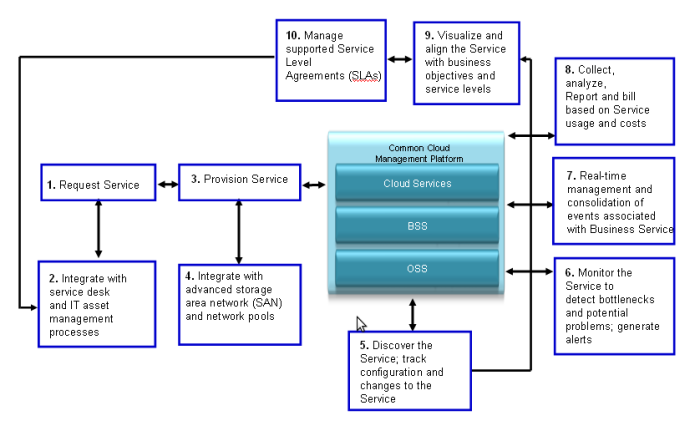Cloud Computing: Typical use cases for Private clouds for better service management
The Private Cloud is different from the others in that the cloud is contained within the enterprise. For example, if the payroll department has a surge in workload on the 15th and 30th of each month, they need enough computing power to handle the maximum workload, even though their everyday workload for the rest of the month is much lower. The actual implementation of the cloud handles this burst (or “elasticity”) using it’s own algorithms for optimum resource usage (Top Dog or Backfill).
There are a number of private cloud providers, however, for any enterprise to make an informed decision, the following use cases must be supported fully:
- Request Service – This is provided via a self-service dashboard which provides users with correct authorisation to request a service (composed of one or more servers, networks, storage, backup and monitoring capabilities), and obtain access to that service after the service approval process. For example, developers in a team may require a set of servers to use as a dev/test bed. A request is put in through the self-service portal, and the cloud administrator(s) may approve it after suitable review
- Integrate with service desk and IT asset management – As new services are provisioned, consumers of the services will require assistance should any problems occur. The helpdesk within the enterprise should then be able to identify the service(s) which may need investigation, and open trouble tickets to track the resolution of the issues. Therefore, it is essential for this integration to exist for private clouds, rather than bolting this integration after deployment of the private cloud. Similarly, a service is made up of several components which need to be identified and tracked by the asset management systems – in the simplest case, the private cloud management software should be able to identify when the available pool of resources needs to be upgraded.
- Provision Service – After a service has been request (and subsequently, approved), it should be provisioned on the private cloud hardware.
- Storage & Network Provisioning – In addition to provisioning of CPU / Memory, true provisioning in private clouds is capable of provisioning storage and (virtual) networking, as required by the service
- Service Discovery & Change history – As services are consumed and changed periodically, their status will change, along with the configuration. For a private cloud provider, it is essential to monitor the health of the service, track the configuration changes and perform an audit for compliance / governance purposes.
- Monitoring – All provisioned services need to be monitored for private clouds. This could be both active and passive monitoring. It is desirable to generate alarms where Service Level Agreements are not being met. This is where the loop with trouble ticketing system is closed (so that tickets are raised automatically as the service status is affected, and SLAs are recomputed)
- Service Dashboard – All that monitoring is used to update a realtime dashboard of service model, depicting availability status for all services in the private cloud
- Metering – Track the usage of each service (in fact, individual elements of a service, such as Network, Storage, IP address remapping, etc), as well as usage stats for software (OS, DB, Application), model billing rates and generate usage reports.
- Visualisation – The cloud management software should provide views for all services provisioned in the cloud (such as hierarchical logical views of elements that make up a service) along with their status. Think of a network map for services.
- Manage Service Level Agreements – Send alarms to administrators when SLAs for configured services are at the risk of breach.
The features above can be depicted in the following diagram:

Leave a comment